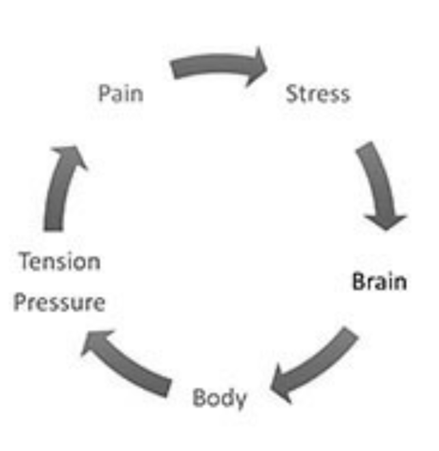Break The Chronic Pain Vicious Cycle
The Chronic Pain Vicious Cycle

What is The Chronic Pain Vicious Cycle?
In Bill Hartman’s book “All Gain, No Pain”, the chronic pain vicious cycle is illustrated as shown above.
People with an acute injury gets trapped in the cycle when the body attempts to protect itself long after the injury has healed. This happens due to different reasons, including stress associated with the injury leading to a defensive mechanism, dysfunctions that happened due to the injury that lingers after healing take place, or even unconscious cravings for the positive experiences during the injury and pain, like care and attention from family and friends.
Factors Reinforcing Chronic Pain Vicious Cycle
In "All Gain, No Pain", Bill brought up that breathing affects movement and posture, and that poor breathing and poor posture reinforces each other. Thus, to break the above cycle of chronic pain, it is important to manage three things: chronic stress, poor breathing patterns and body misalignments.
Chronic Stress

Manage Chronic Stress
Chronic stress can be managed by improving sleep, digestion and address overall stress.
Improve sleep, both quantity and quality, to allow better recovery from daily activities to manage chronic stress. Ideally, have 6-8 hours of sleep with regular sleeping hours and schedule. Sleeping environment should also be dark, cool, quiet and without wi-fi devices. Stress busting activities before bedtime like meditation, prayer, and grateful journal are helpful. Washing down half a tea spoon of salt with water also provides the body with minerals that aids in better sleep.
Address digestion to reduce load on the body's internal organs to manage chronic stress. Look out for symptoms of intolerance/allergy like constipation and bloating. Eliminate suspected food for 3-6 weeks before reintroducing them to check how body responds to the reintroduced food. Some of the common food that can cause intolerance are diary, wheat, soy, nuts, shellfish and eggs. Stay hydrated throughout the day and have enough fibre (from veges or supplements). Have digestive enzymes if necessary.
Address overall stress to manage chronic stress. Common sources of overall stress includes sleep, digestion (mentioned previously), emotional stress and over-training. Emotional stress can be managed with pre-bedtime stress busting activities mentioned earlier, while over-training can be addressed by reducing the volume of workout by half for better recovery and adaptation. In general, daily stress results in more tension and harder to relax, which can be addressed by supplements that aid in relaxation, like Magnesium. In the event of accumulated overall stress causing adrenaline fatigue whereby low energy level is experienced throughout most of the day, adrenals support supplements (like Vit C) can be helpful.
Manage Chronic Stress overview
Sleep
| Digestion
| Overall Stress
|
|---|---|---|
Environment
| Food intolerances
| Sleep
|
Stress busting activities
| Hydration
| Digestion
|
Sleeping hours
| Fibre intake
| Emotional
|
Supplements
| Digestive enzymes
| Training
|
Daily stress
| ||
Adrenals support
|
Poor Breathing Patterns

Manage Poor Breathing Patterns
Poor breathing patterns can be managed by diaphragm breathing, improving breath quality and reducing breath rate.
Diaphragm is the primary breathing muscle. However, it is often underused with breath reaching mostly only the top parts of the lungs. Increase use of diaphragm in breathing can be achieved by nose breathing as well as loosening and activating the diaphragm.
Breath quality can be improved by deepening the breath, allowing air to reach the pelvic floor. This is made possible only after the diaphragm is loosened and activated. It is also important to know the difference between "deep" breath and "big" breath. The aim is to reduce the breath size while maintaining depth. Lastly, do not be so caught up with breathing in but forget about breathing out completely before breathing in again.
Breath rate should be slowed down as much as possible at rest to simulate the effects of low stress levels. After all, highly stressful periods cause the opposite, an increase in breath rate at rest. Ideally, one should be able to maintain breath hold for longer than 30 seconds at rest upon completely breathing out with nose pinched and lips sealed. Tempo based breathing (like "inhale-hold-exhale" with 6-2-7 from renaissance breathing) can be practiced to keep breath rate under control.
Manage Poor Breathing Patterns overview
Diaphragm
| Breath quality
| Breath rate
|
|---|---|---|
Nose breathing
| Deep
| Hold
|
Loosen
| Small
| Slow
|
Activation
| Complete
| Control
|
Body Misalignment

Manage Body Misalignments
Body misalignments are poor posture related to compensations caused by various factors, including those mentioned below.
Structural issues like torn cartilage/ligaments, lax joints, bunions and injured discs in the spine would cause awkward movements in involved joints and over reliance on other joints or body parts. Such compensations can be managed by targeted strengthening of involved joints and surrounding muscles as well as core stabilizing works.
Spinal distortion means a misalignment in the vertebrae resulting in the spine being out of shape. Such misalignment can be overcome with adjustments to the vertebrae, which can include spinal manipulation like chiropractic care.
Sensors of the body, when mis-adjusted, causes poor perception of the surroundings, leading to poor body positioning both at rest and during movement. Such compensations can be minimized by "readjusting" the sensors.
External factors like inappropriate equipment (eg, under-sized footwear, wi-fi devices) harsh environment and bad physical setup can cause compensations due to discomfort, weaknesses and restrictions in movements. Such compensations can be avoided by careful selection of the right equipment regulating indoor conditions and making the proper physical adjustments.
All the above mentioned factors also lead to muscular imbalances, whereby muscles are selectively over- or under- activated, which also cause compensations and body misalignments. Muscular imbalances can be managed by addressing the above mentioned factors and loosening/activating the relevant muscles.
Manage Body Misalignments overview
Structural issue
| Spinal distortion
| Sensors mis-adjustments
| External factors
| Muscle imbalances
|
|---|---|---|---|---|
Stabilize
| Cervical
| Eyes
| Equipment
| Lower body
|
Mobilize
| Thoracic
| Jaws
| Environment
| Upper body
|
Core works
| Lumbar
| Deep skin scars
| Physical setup
| Spine
|
Foot arch
| Others
| |||
Body receptors
|
Summary
To summarize, break out of the chronic pain vicious cycle by addressing the following factors: chronic stress, poor breathing patterns and body misalignments.
To address chronic stress, improve sleep and digestion while addressing overall stress.
To manage poor breathing patterns, implement diaphragm breathing, improve breath quality and reduce breath rate.
To manage body misalignments, manage structural issues, minimize sensors mis-adjustments, manage external factors and manage muscle imbalances.
Break the chronic pain vicious cycle overview
Chronic stress
| Poor breathing patterns
| Body misalignments
|
|---|---|---|
Sleep
| Diaphragm
| Structural issues
|
Digestion
| Breath quality
| Spinal distortion
|
Overall stress
| Breath rate
| Sensors mis-adjustments
|
External factors
| ||
Muscle imbalances
|
Conclusion
To conclude, many people experience chronic pain either due to past injuries that should have healed or for no apparent reason. These stubborn pain hinders one from enjoying their lives and cause frustrations. The solutions given in this article, when applied appropriately, would help you to break free of the chronic pain vicious cycle!
Which one of the above factors strikes you the most. Share with me in the comments section below!
Pain relief by Breaking The Chronic Pain Vicious Cycle
I do work closely with individuals to relief chronic and recurring pain by breaking the chronic pain vicious cycle as part of a holistic pain solution illustrated in my other article "Permanent Relief From Recurring Pain".
As part of breaking the chronic pain vicious cycle, I also work on managing chronic stress, poor breathing patterns and body misalignments, illustrated in my other articles "A Deeper Look Into Manage Chronic Stress", "A Deeper Look Into Manage Poor Breathing Patterns" and "A Deeper Look Into Body Misalignments".
Contact me for more information if you are looking to break the chronic pain vicious cycle, manage chronic stress, poor breathing patterns, body misalignments or holistically overcome ongoing pain!
© 2020 Bing Xi








